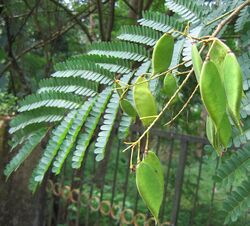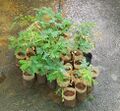Biology:Biancaea sappan
| Biancaea sappan | |
|---|---|

| |
| Leaves and fruits | |
| Scientific classification | |
| Kingdom: | Plantae |
| Clade: | Tracheophytes |
| Clade: | Angiosperms |
| Clade: | Eudicots |
| Clade: | Rosids |
| Order: | Fabales |
| Family: | Fabaceae |
| Subfamily: | Caesalpinioideae |
| Genus: | Biancaea |
| Species: | B. sappan
|
| Binomial name | |
| Biancaea sappan (L. 1753) Tod. 1875
| |
| Synonyms | |
| |
Biancaea sappan is a species of flowering tree in the legume family, Fabaceae, that is native to tropical Asia. Common names in English include sappanwood and Indian redwood.[2] It was previously ascribed to the genus Caesalpinia.[3] Sappanwood is related to brazilwood (Paubrasilia echinata), and was itself called brasilwood in the Middle Ages.[4]
Biancaea sappan can be infected by twig dieback (Lasiodiplodia theobromae).[5]
This plant has many uses. It has antibacterial and anticoagulant properties.[citation needed] It also produces a valuable reddish dye called brazilin, used for dyeing fabric as well as making red paints and inks.[lower-alpha 1] Slivers of heartwood are used for making herbal drinking water in various regions, such as Kerala, Karnataka and Central Java, where it is usually mixed with ginger, cinnamon, and cloves. The heartwood also contains juglone (5-hydroxy-1,4-naphthoquinone), which has antimicrobial activity.[7] Homoisoflavonoids (sappanol, episappanol, 3'-deoxysappanol, 3'-O-methylsappanol, 3'-O-methylepisappanol[8] and sappanone A[9]) can also be found in B. sappan.
The wood is somewhat lighter in color than brazilwood and other related trees. Sappanwood was a major trade good during the 17th century, when it was exported from Southeast Asian nations (especially Thailand) aboard red seal ships to Japan .
Gallery
Notes
References
- ↑ World Conservation Monitoring Centre (2018). "Biancaea sappan". IUCN Red List of Threatened Species 2018: e.T34641A127066650. doi:10.2305/IUCN.UK.2018-1.RLTS.T34641A127066650.en. https://www.iucnredlist.org/species/34641/127066650. Retrieved 19 November 2021.
- ↑ {{citation | mode = cs1 | title = sanscrit :Patranga:Caesalpinia sappan L. | work = Germplasm Resources Information Network (GRIN) | url = https://npgsweb.ars-grin.gov/gringlobal/taxonomydetail.aspx?8309 | publisher = [[Organization:Agricultural Research ServAgricultural Research Service (ARS), United States Department of Agriculture (USDA) | access-date = Jul 6, 2016 }}
- ↑ "A new generic system for the pantropical Caesalpinia group (Leguminosae)". PhytoKeys (71): 1–160. 2016. doi:10.3897/phytokeys.71.9203. PMID 28814915.
- ↑ Von Muralt, Malou (November 2006). "A árvore que se tornou país" (in pt-br). Revista da USP 71: 171–198. ISSN 0103-9989. https://www.revistas.usp.br/revusp/article/view/13560/15378. Retrieved 29 January 2023.
- ↑ "CAB Direct". http://www.cabdirect.org/abstracts/20073191731.html.
- ↑ Arai, Masanao; Iwamoto Wada, Yoshiko (2010). "BENI ITAJIME: CARVED BOARD CLAMP RESIST DYEING IN RED" (PDF). Textile Society of America Symposium Proceedings (University of Nebraska - Lincoln). https://digitalcommons.unl.edu/cgi/viewcontent.cgi?article=1004&context=tsaconf.
- ↑ Lim, M.-Y.; Jeon, J.-H.; Jeong, E. Y.; Lee, C. H.; Lee, H.-S. (2007). "Antimicrobial Activity of 5-Hydroxy-1,4-Naphthoquinone Isolated from Caesalpinia sappan toward Intestinal Bacteria". Food Chemistry 100 (3): 1254–1258. doi:10.1016/j.foodchem.2005.12.009.
- ↑ Namikoshi, Michio; Nakata, Hiroyuki; Yamada, Hiroyuki; Nagai, Minako; Saitoh, Tamotsu (1987). "Homoisoflavonoids and related compounds. II. Isolation and absolute configurations of 3,4-dihydroxylated homoisoflavans and brazilins from Caesalpinia sappan L". Chemical & Pharmaceutical Bulletin 35 (7): 2761. doi:10.1248/cpb.35.2761. http://ci.nii.ac.jp/naid/110006281320/.
- ↑ Chang, T. S.; Chao, S. Y.; Ding, H. Y. (2012). "Melanogenesis Inhibition by Homoisoflavavone Sappanone a from Caesalpinia sappan". International Journal of Molecular Sciences 13 (8): 10359–10367. doi:10.3390/ijms130810359. PMID 22949866.
External links
Wikidata ☰ {{{from}}} entry
 |






